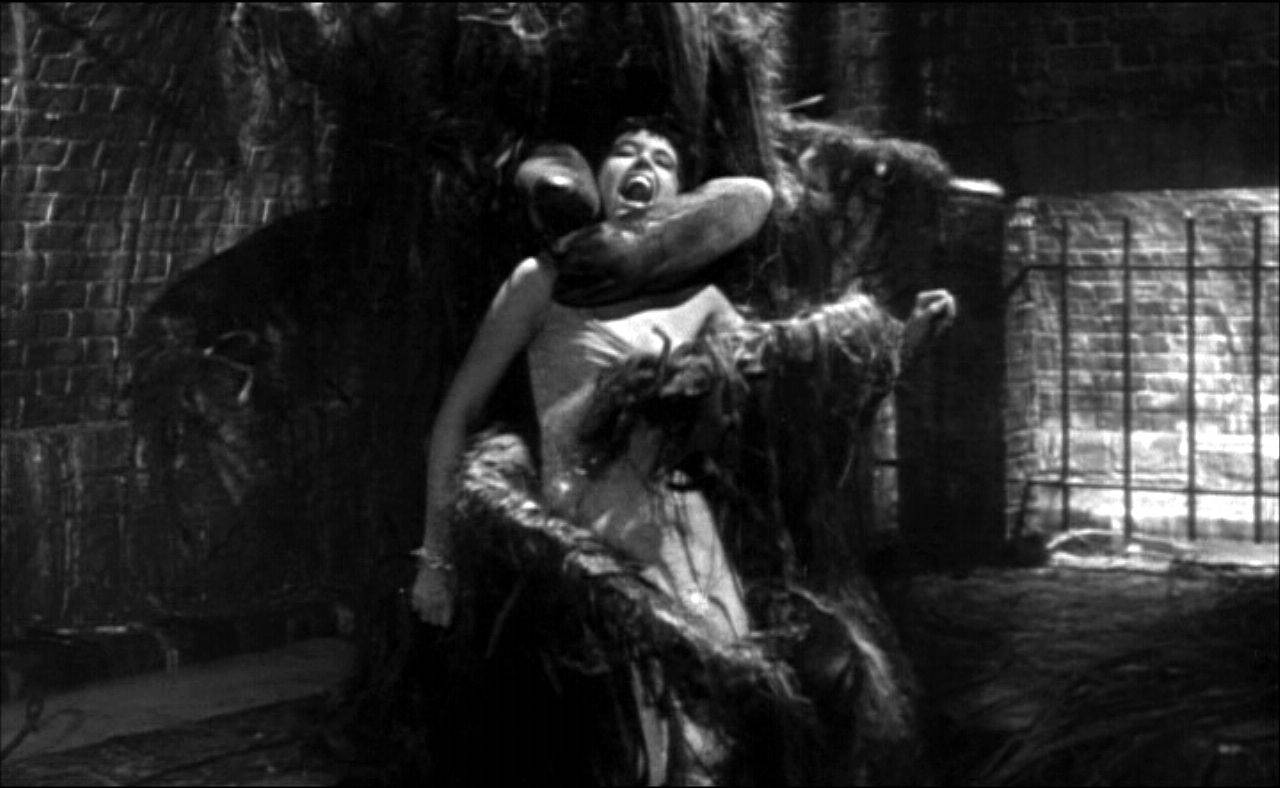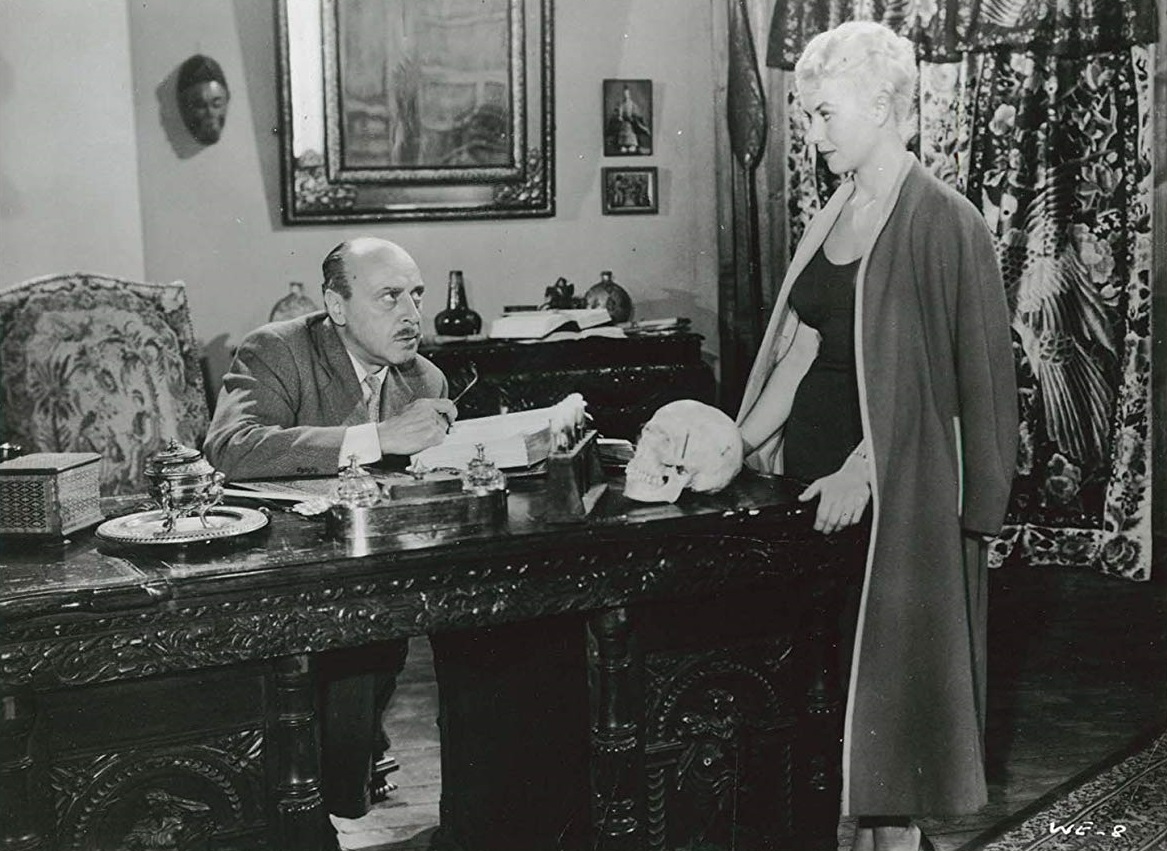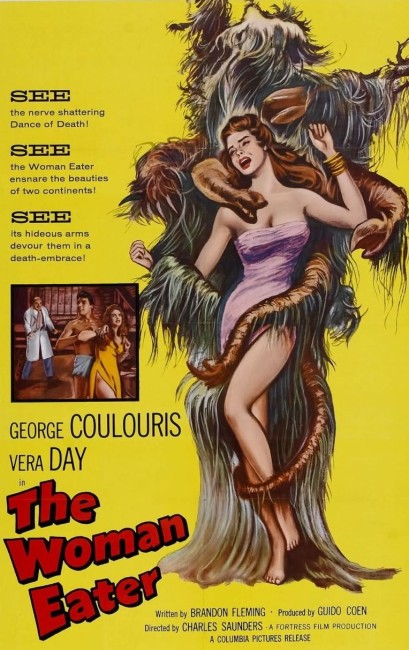aka The Woman Eater
Crew
Director – Charles Saunders, Screenplay – Brandon Fleming, Producer – Guido Coen, Photography (b&w) – Ernest Palmer, Music – Edwin Astley, Makeup – Terry Terrington, Art Direction – Herbert Smith. Production Company – Fortress Films.
Cast
George Coulouris (Dr James Moran), Vera Day (Sally Norton), Joyce Gregg (Margaret Santor), Peter Wayn (Jack Venner), Jimmy Vaughan (Tanga), Maxwell Foster (Detective-Inspector Brownlow), Joy Webster (Judy), Alexander Field (Fair Attendant), Robert MacKenzie (Lewis Carling), Edward Higgins (Sergeant Bolton), Sara Leighton (Susan Curtis)
Plot
Dr James Moran visits the Explorer’s Club in London and proposes an expedition to remote parts of the South American jungle in search of an Inca drug that can purportedly resurrect the dead. On the expedition, he comes across natives sacrificing a woman to a plant creature. Five years later, Moran has returned to England with the plant creature where he is sacrificing women to it in the hopes of producing a resurrection serum. He is visited by police who are searching for one of the missing girls. Meanwhile, local mechanic Jack Venner tries to charm Sally Norton, the girl hawking an attraction at a local fair, only for her to be fired. He suggests that she go to Moran and ask a job. Moran hires Sally but soon starts to become infatuated with her.
Womaneater, listed as The Woman Eater in the US and on some posters, is a rare example of the British mad scientist film. The UK seemed to miss out entirely on the era of mad scientist films that overtook Hollywood during the 1930s and 40s. There were a slim number of mad scientist films produced during the great period of English horror (1957-79) – Konga (1961), The Blood Beast Terror (1968), Scream and Scream Again (1970) and Horror Hospital (1973), most of which planted tongue in cheek. The medical vampire film Blood of the Vampire (1958) could also be counted here.
Nobody who has written about the Anglo-horror cycle has good things to say about Womaneater. It is worth noting that it came out the same year as Hammer made The Curse of Frankenstein (1957), which launched the Anglo-horror cycle. Where Hammer took the ambitious step of shooting in colour with lush production values that pushed the censorship envelope and were clearly aiming for the international market, Womaneater is shot in black-and-white, plodding and cosily rural in nature, giving all evidence of being no more than a quota quickie. It would have been perfectly serviceable as a studio B film starring Bela Lugosi in the mid-1940s but up against the boldness of Hammer’s offerings, it seems to be an English horror film that is only looking backwards to other models.
Womaneater radiates a cheapness in most respects. There is a painfully tatty plant monster, which when seen (mercifully briefly) with its multiply chomping mouths would have to sit up amongst the pantheon of the most laughable movie monsters. One of the worst aspects are the opening scenes in the South American jungle where quite clearly the filmmakers have done absolutely nothing to research the culture of the Incas (almost all of which had been obliterated by the Spanish in the 17th Century) and have just made them out like cliche African tribes wearing headdresses, banging jungle drums, engaged in voodoo rites and speaking in pidgin English.


The title Womaneater gives the film a certain racy suggestiveness that either makes you think of one of the British sex comedies of the 1970s or else of a cannibal film. In reality, it is a purely sensationalistic title that the film seems awfully unimaginative about fulfilling – we get one or two girls fed to the plant creature but no gore, while the film is less concerned with the issue of women being fed to plants than George Coulouris’s obsession with having his way with Vera Day at the same time as rebuffing his middle-aging housekeeper/ex Joyce Gregg.
The most colourful scenes are the brief ones where George Coulouris goes prowling the Piccadilly Circus red light and stripper area for victims, something that briefly gives the film a vibrancy that the rest of the staid countryside scenes lack. Even then, director Charles Saunders fails to push this to the level of amusing sordidness that The Brain That Wouldn’t Die (1963) did with similar such scenes.
Charles Saunders was a regular director of British quota quickies. His only other film, also starring George Coulouris, was as co-director of the deranged The Man Without a Body (1957) about Nostradamus’s disembodied head.

